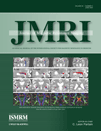Diffusion-weighted echo-planar magnetic resonance imaging for the assessment of tumor cellularity in patients with soft-tissue sarcomas
Abstract
Purpose
To investigate the eligibility of diffusion-weighted imaging (DWI) for the evaluation of tumor cellularity in patients with soft-tissue sarcomas.
Materials and Methods
Thirty consecutive patients with a total of 31 histologically-proven soft-tissue sarcomas prospectively underwent magnetic resonance imaging (MRI) including DWI with echo-planar imaging (EPI) technique immediately before open biopsy (N = 1) or tumor resection (N = 30). Fourteen patients had no previous anticancer treatment, 16 had received neoadjuvant therapy. Tumor cellularity as determined from histological sections was compared with minimum apparent diffusion coefficient (ADC).
Results
Tumor cellularity correlated well with minimum ADC in a linear fashion, with a Pearson correlation coefficient of –0.88 (95% confidence interval [CI]: –0.75 to –0.96). This relationship was not influenced by prior anticancer treatment. There was only a tendency toward lower ADC in tumor with higher grading but no significant dependency (P = 0.08).
Conclusion
DWI has proven useful for the assessment of tumor cellularity in soft-tissue sarcomas. In result, DWI may be used as a powerful noninvasive tool to monitor responses of cytotoxic treatment as reflected by changes in tumor cellularity. J. Magn. Reson. Imaging 2009. © 2009 Wiley-Liss, Inc.




